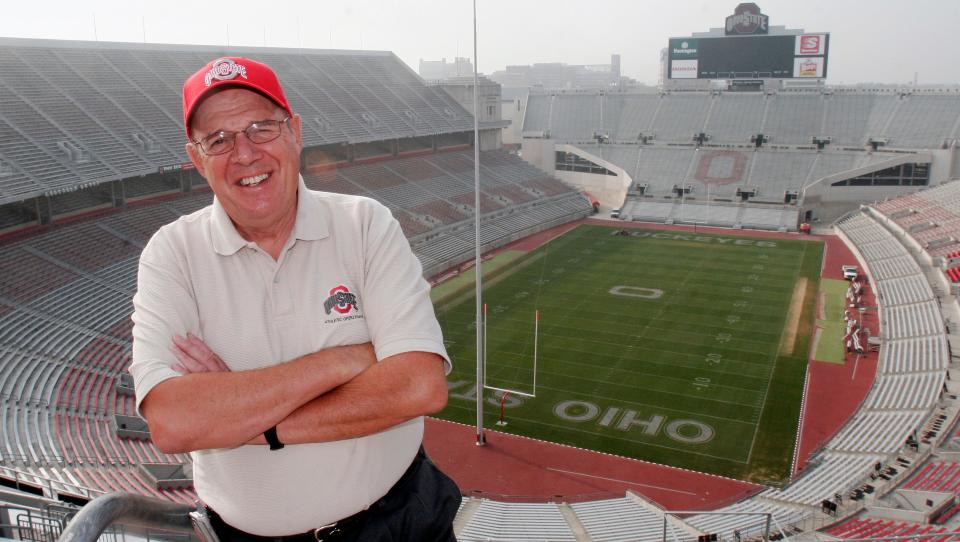Rob Oller | Former Ohio State AD Andy Geiger laments gap between haves and have-nots
Careful what you wish for.
For a little more than a decade, from 1994 to 2005, Andy Geiger built things. And spent big while doing it. As Ohio State athletic director, Geiger gets credit — or deserves blame, depending on one’s view of deficit spending — for overseeing construction of the Schottenstein Center, Younkin Success Center, Bill Davis Baseball Stadium and a major renovation of Ohio Stadium.
It was on his watch that Geiger proudly contributed to the corporatizing of college athletics, yet the retired 82-year-old now wonders what has been wrought. In that way, he is like the Tim Berners-Lee of collegiate sports.
Berners-Lee in 1989 came up with the idea that would become the World Wide Web. His innovation began as an aide to scientists to share data across the Internet, which had existed since the 1960s only as a government tool. Berners-Lee released his source code for free, opening the Web as a platform for all.
Three decades later Berners-Lee regrets how the Web shares many negatives — hackers, secret psychological experiments, fake news — with the positives of educational information and mass communication.
So it is with Geiger and college sports. He sees the positives of progress, including increased rights and opportunities for athletes, tempered by excesses and continuing lack of equity — particularly relating to name, image and likeness.

Not that he loses sleep over it. His main activity these days is playing jazz saxophone in clubs near his home northwest of Seattle. But his chill vibe turns to concern when talking about the state of college athletics.
“I used to feel like I retired,” Geiger said. “Now I feel like I escaped.”
One of his pressure points is NIL, which he approves of in theory but worries about in practice.
“The trouble I have, for the old fogy that lives inside me, is that as a guy who fought pretty hard for values of Title IX and the idea that there ought to be the same opportunities for anybody who wants it, regardless of gender, is that I know in my heart that NIL is not a factor for synchronized swimmers.”
Just as troubling to Geiger is that as expenses escalate across college sports, due in part to coaching salaries, facility upgrades and the need to be the biggest and best, the only way to maintain equity will be to cut men's sports.
“Title IX was out of balance when we arrived at Ohio State, so we added women’s rowing and lacrosse and hockey,” he said. “Unfortunately, most other schools were dropping men’s teams to make the numbers equal, which was opposite of what the values should be. I was always proud of Ohio State for understanding what the (Title IX) law was all about. The administration was great in getting that.”
But now?
“That’s all going to go down the toilet,” Geiger said, adding that marketplace forces are negatively impacting fair and even-handed treatment across sports, resulting in the slashing of some programs.
Ohio State continues to hold steady with 36 varsity sports, the most in the nation. But Geiger doesn’t see how it lasts.

“As far as I can see, from 40,000 feet, (Ohio State) has done a tremendous job of keeping it going, but I don’t envy them with having to do the inevitable,” Geiger said. “If you want to be Ohio State in football and to some extent in men’s basketball and to a lesser extent women’s basketball, beyond that you’re going to have tiered athletics.”
Tiered is a nice way of saying club sports and intramurals.
“I bemoan that, but I’m not going to criticize anybody. That’s not my right,” Geiger said.
The irony is that Geiger spent money to solve problems that created other problems. In a vicious financial cycle, reaching program equity requires the kind of dollars that escalate athletic department costs, which further challenge the department’s ability to maintain equity.
Geiger upgraded non-revenue sports athletic facilities and praises OSU athletic director Gene Smith for continuing to build first-class complexes.
“What Gene and his group have accomplished since 2006 is a miracle,” he said.
But sooner than later, the price tag of pursuing program equity, paying athletes cost of attendance stipends and spending on NIL infrastructure, including increasing the size of compliance departments, will take its toll.
“We’re moving more toward professionalism,” Geiger said. “I don’t begrudge (NIL), but it flies in the face of the core values. You’ve got over 100 schools involved in Division I football, and all this is going to do is exacerbate the haves and have-nots.”
That said, Geiger admitted he would not be one to push back hard against NIL legislation.
“If I were sitting in those rooms I’d probably be voting for what they’re doing, and then try to figure out how to do it, because you know what side of the bread is buttered. So I’d go along, but hold my nose while doing it.”
Spoken like a musician who understands that with all that jazz, the challenge is to blend tension and resolution into something that works well in concert.
This article originally appeared on The Columbus Dispatch: Ohio State still has 36 varsity sports, but how long can it last?
